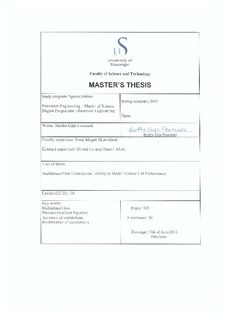| dc.contributor.author | Fossmark, Marthe Gilje | |
| dc.date.accessioned | 2011-10-28T10:41:35Z | |
| dc.date.available | 2011-10-28T10:41:35Z | |
| dc.date.issued | 2011 | |
| dc.identifier.uri | http://hdl.handle.net/11250/183343 | |
| dc.description | Master's thesis in Petroleum engineering | no_NO |
| dc.description.abstract | The Statfjord Field has entered a drainage strategy where the reservoir will be depleted such that gas liberates from the remaining oil in the reservoirs. Adequate modelling of vertical lift performance is needed to predict a realistic liquid offtake and thereby pressure-depletion rate. Wells in the Statfjord Formation have been producing from a gas cap in which some areas of the formation has disappeared. Production tests from wells located in such areas have been used as basis when analysing multiphase-flow correlations’ ability to model vertical lift performance.
Calculations are done in Prosper, a well performance, design and optimization program developed by Petroleum Experts. Conceptual test data describing liquid and gas-condensate wells were sett up to study prediction of pressure drop, and differences between correlations. Measured downhole pressures from 203 production tests, from six wells located in the Statfjord Formation, were used to compare accuracy of correlations. Petroleum Experts, Petroleum Experts 2 and Petroleum Experts 3 were found to be the most accurate correlations, and were recommended to use when creating lift curves for the Statfjord full field model.
A trend of too low pressures predicted at low gas-liquid ratio (GLR), and too high pressures predicted at higher GLR was observed. An attempt of making the correlation even more accurate for a wider gas-liquid range was done by tuning in Prosper. None of the attempted modifications gave increased accuracy for the whole GLR range studied. It was proposed that modification to equations for liquid holdup, or in flow regime boundaries may improve accuracy over a wider GLR range.
A study of using tuned correlations and possible errors introduced when predicting future performance was performed. Only small errors were observed for a narrow GLR range (as for the Brent Group, 50 – 300 Sm3/Sm3), and one correlation can be used for the entire time range. With higher gas-liquid ratios, errors introduced by using correlations tuned to test data may be significant, and it was recommended to change correlation as function of GLR development. A recommendation of correlations to use and how they may be modified when predicting future performance of the Statfjord Field is included. | no_NO |
| dc.description.sponsorship | Statoil ASA | no_NO |
| dc.language.iso | eng | no_NO |
| dc.publisher | University of Stavanger, Norway | no_NO |
| dc.relation.ispartofseries | Masteroppgave/UIS-TN-IPT/2011; | |
| dc.subject | petroleumsteknologi | no_NO |
| dc.subject | multiphase flow | no_NO |
| dc.subject | pressure-gradient equation | no_NO |
| dc.subject | accuracy of correlations | no_NO |
| dc.subject | modifications of correlations | no_NO |
| dc.title | Multiphase-flow correlations' ability to model vertical lift performance | no_NO |
| dc.type | Master thesis | no_NO |
| dc.subject.nsi | VDP::Technology: 500::Rock and petroleum disciplines: 510::Petroleum engineering: 512 | no_NO |
